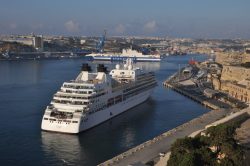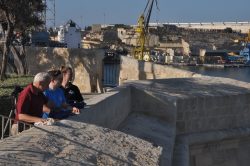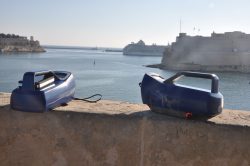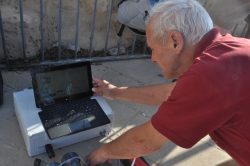On the weekend of the 23rd and 24th of June 2018, BirdLife Malta carried out a second air quality measurement exercise, monitoring the arrival and departure of four cruise liners and several smaller ships at the Valletta Grand Harbour as part of our ongoing Together against Air Pollution from Ships project. Air samples taken opposite to the cruise ship terminal in Senglea show high concentrations of ultrafine particles and NO₂ in the presence of cruise liners, passing by and berthing in the port.
 With the support of experts from our BirdLife partner in Germany, Nature and Biodiversity Union (NABU), and air quality expert Dr Axel Friedrich, we measured high levels of air pollution at Gardjola Gardens. Levels of ultrafine particles went up to 110,000 pt/cm³ (particles per cubic centimetre) and NO₂ volumes up to 135 µg/m³ (microgram per cubic metre) at around 8:00 during the arrival of one cruise liner and one already berthing at the Valletta Cruise Port. Another cruise liner departing Valletta around 18:00 emitted at its maximum 74,000 pt/cm³ of ultrafine particles and 166 µg/m³ of NO₂.
With the support of experts from our BirdLife partner in Germany, Nature and Biodiversity Union (NABU), and air quality expert Dr Axel Friedrich, we measured high levels of air pollution at Gardjola Gardens. Levels of ultrafine particles went up to 110,000 pt/cm³ (particles per cubic centimetre) and NO₂ volumes up to 135 µg/m³ (microgram per cubic metre) at around 8:00 during the arrival of one cruise liner and one already berthing at the Valletta Cruise Port. Another cruise liner departing Valletta around 18:00 emitted at its maximum 74,000 pt/cm³ of ultrafine particles and 166 µg/m³ of NO₂.
Second air measuring exercise carried out at Valletta port as part of a project monitoring air pollution from ships
This means that during the summer months where up to seven cruise liners can be catered for at full capacity at the port, these ships contribute to a great extent to the already critical levels of air quality present in Malta. Among other data, Air Quality Index estimates published by the European Environment Agency at the beginning of 2018, rate Malta’s air quality as very poor.
In contrast to the progress in reducing emissions from land-based sources such as the standard use of exhaust gas cleaning systems for cars, trucks and power plants; shipping emissions of nitrogen oxides are not obliged to be filtered to the same extent. This could be easily witnessed by comparing data of ultrafine particles measured at Marsa Junction around midday on 23rd June. Heavy traffic present during that time measured an average level of ultrafine particles of 16,000 pt/cm³.
Axel Friedrich stated: “ship emissions have an effect on human health diminishing the function of lungs and increasing the risk of cardiovascular disease as well as asthma particularly caused by nitrogen oxides and ultrafine particles”.
 This is particularly striking for Malta. The EU’s Environmental Implementation Report on Malta published last year, shows that health-related external costs from air pollution are above €182 million/year and 44,000 work days are lost each year due to sickness leave related to air pollution. These costs are covered under public funded health care.
This is particularly striking for Malta. The EU’s Environmental Implementation Report on Malta published last year, shows that health-related external costs from air pollution are above €182 million/year and 44,000 work days are lost each year due to sickness leave related to air pollution. These costs are covered under public funded health care.
Populations living in close distance to the port are the most effected by air pollution from ships. However particles are also carried hundreds of kilometers where they contribute to local air quality problems even away from ports. Figures by the European Commission estimate 50,000 people die prematurely every year in Europe due to air pollution from ships.
 BirdLife Malta believes that air pollution is one of the major environmental issues in the world along with plastic use and direct wildlife crime. Anything that effects our natural environment affects us as humans too and nothing more directly than the air we breathe. This is why BirdLife Malta embarked on this project and once more it is basing all its arguments, advice and assistance on proper scientific research.
BirdLife Malta believes that air pollution is one of the major environmental issues in the world along with plastic use and direct wildlife crime. Anything that effects our natural environment affects us as humans too and nothing more directly than the air we breathe. This is why BirdLife Malta embarked on this project and once more it is basing all its arguments, advice and assistance on proper scientific research.
We call on the Government to address air pollution from ships in Malta appropriately and take responsibility to be a role model shifting to zero emissions from the shipping sector.
Air pollution affects everyone, therefore any strategies to reduce air pollution must balance environmental and economic interests.
Read the Maltese version of the press release here. You can also read more about the results of the air quality measurement exercise here.

